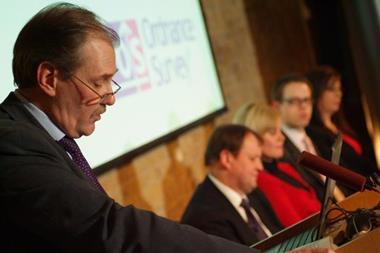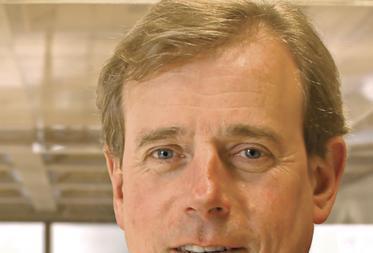The institution is having another go at building a market-wide electronic system. Lauren MacGillivray meets the dynamic duo leading the Exchange pilot: Sue Langley of Lloyd’s and Luke Robertson of IBM
Sue Langley is only too aware how much is riding on the Lloyd’s Exchange pilot. Kinnect, the institution’s previous attempt at a market-wide electronic trading platform, was scrapped in early 2006 and the £70m failure is still a source of embarrassment.
When asked about Kinnect, the Lloyd’s director, market operations and North America, clears her throat, shifting on the black leather couch. But then she relaxes into a laugh and says: “It’s fine, it was before my time – I can talk about it.”
Langley is in charge of implementing the Exchange project, a market initiative to facilitate the electronic exchange of information through a central messaging hub. She met Insurance Times with Luke Robertson of IBM, which won the tender to build and operate the hub in January. The pilot begins on 1 June and runs until the end of August. The pair explained their plans to force through an electronic revolution in a reluctant market – and insisted that this time it will work.
It has been argued that Kinnect failed in part because brokers prefer face-to-face discussions. But that excuse doesn’t cut it any more – and last year Lloyd’s realised it had to take action.
Persuading participants should be a little easier this time. The system isn’t a trading platform like Kinnect; it will simply enable brokers, insurers and back-office departments to share information using a single standard or language.
The Exchange will accept or reject information based on the Association for Cooperative Operations Research and Development (Acord) messaging standard. This means individual technology suppliers won’t be able to develop a monopoly.
IBM is providing the central hub for a price that is believed to be less than £1m; Lloyd’s has committed to covering the cost for the first three years. A market spokesman said IBM was chosen after a selection process that began with more than 20 interested parties.
While the Exchange will facilitate information sharing, other technology firms will provide the rest of the functions – front-end suppliers that enable connectivity to the Exchange; back-office suppliers that give brokers and managing agents operating systems for trading activities; and business service suppliers that build the actual trading platforms.
“[The Exchange] is just the infrastructure that allows you to send the message, so this time it’s about recognising the diversity in the market,” says Langley.
“We’re not putting in any functionality that says, ‘Thou shalt operate in this manner’. We’re allowing every managing agent to operate how they want – they can do it internally, or use a trading platform like RI3K, for example.
“We’re just putting in the ring that actually connects it all. So it actually enables choice by imposing a standard.”
But Robertson, an associate partner in the insurance practice at IBM Global Business Services, says technology suppliers will still have to adapt their systems to integrate with the Exchange.
“We want to build a network of suppliers who, when they’re supplying their services and their products, are connected or ready to connect to the Lloyd’s Exchange, therefore making it easier for adoption for participants. We also want to make sure that while the Exchange has an enabling capability of allowing data to transfer, the real benefits come from when those platforms and other services are plugged on to it.”
Three suppliers have been given the nod so far: RI3K, Trace and TriSystems. Lloyd’s is in talks with more than 20 key suppliers, which Langley says will cover about 70% of the market.
Managing agents, meanwhile, are also showing strong interest. The 12-month pilot has four phases and the first one is fully booked with 18 managing agents (plus brokers and suppliers), all of them volunteers. They represent only a fraction of the market, but Lloyd’s is restricting the numbers initially, until the technology is proven.
Langley says the participants all want different things from the Exchange – features such as placing, accounting or endorsements. As a result, she says, the pilot will build a “roadmap” of the features that will be available.
Several big hurdles remain – achieving a cultural shift at Lloyd’s, attracting enough take-up by market participants and suppliers, and proving the technology is viable.
Robertson says the technology is already proven because it is based on the same core infrastructure and management team as imarket – the web trading platform also built up by IBM and set up by insurers for commercial lines. But that system has had its own problems with take-up. As of September last year, about 3,000 broker firms had signed up.
Robertson says the key issue for the Exchange is getting the right adoption in the market. “We can support that. But ultimately it comes down to the decisions of the individual organisations.”
So it looks like the task rests on Langley’s shoulders. And judging by her CV, she’s up to the job. In addition to being on the Acord board, she’s a member of the London Market Reform Group. She also chaired the “G6”, a group of six managing agents formed in January 2004 and charged with improving Lloyd’s processes.
She joined Lloyd’s in July 2007 from Hiscox, where she was chief operating officer. Before that, she was a principal consultant at PricewaterhouseCoopers, specialising in change management. She is optimistic but cautious about the change coming at Lloyd’s, and stresses that the Exchange will not be mandated.
“We’re not trying to tell people how to do something, we’re just trying to make their life easier. Also, it’s a very small step and it was market-led. When I first joined, a lot of people said, ‘Sue, what is Lloyd’s going to do now?’ We had multiple suppliers, which is a good thing, but a lot of people were frightened about making the wrong choice – like VHS and Betamax.
“We could have built another type of Kinnect and picked one or two suppliers, but we decided to allow competition just like we do in franchising and claims.”
Not everyone is convinced and she concedes that she has heard the negative comments. “I’m always disappointed when people throw stones. If there’s something wrong with it, tell us and we’ll improve or resolve it.”
Overall, however, Langley says the response has been positive because this time, it’s not “smoke and mirrors”. It also helps that Lloyd’s has made strides in other areas such as electronic claims and accounting settlement.
As for whether the system could go global, Robertson says: “Because we use American technology standards, anything they do to connect to this internally through their own organisations will be available and useful for any future hubs that come out.”
But Langley, determined not to see Lloyd’s get burnt again, counters: “Some people have asked and so far I’ve said that’d be a nice problem to have. If we think too far ahead we won’t deliver here, so I know lot of people would like to open that debate. There’s no reason why it couldn’t but our focus is here.”
Over the coming months, expect to hear Langley’s mantra a lot: “You’ve just got to keep repeating the message – it’s small, it’s simple, it’s market-led and it sets standards.”
Hosted by comedian and actor Tom Allen, 34 Gold, 23 Silver and 22 Bronze awards were handed out across an amazing 34 categories recognising brilliance and innovation right across the breadth of UK general insurance.














































No comments yet